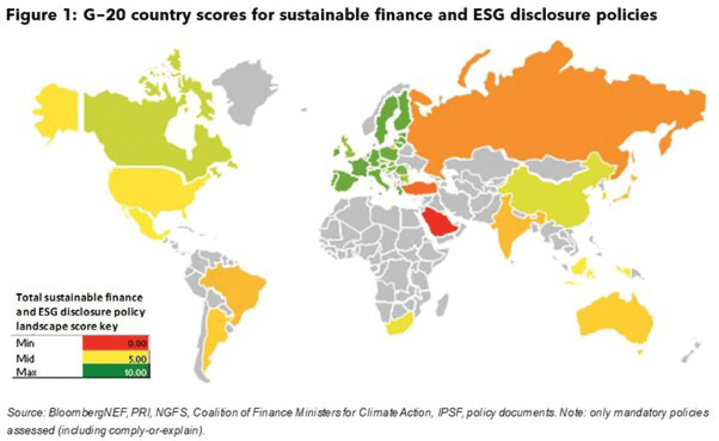By now we all know what ESG stands for. The investment community now considers environmental, social, and governance reporting as major intangible factors for determining the performance of an organization. But it wasn’t like this two decades ago.
Back in the days when business meant only making money
Going to court and paying compensation was all companies could do if they were caught. Back in the 1960s, when environmental adversities owing to indiscriminate use of pesticides called out corporations, it was business as usual after the compensations. Companies continued to look at profits before environmental issues even after the Brundtland Commission of the United Nations defined sustainable development in 1987. These events although sowed the seed of socially responsible investing in investors.
At the world’s stage, top financial institutions discussed the connection of environmental and social factors with the economy. In 1992, the United Nations Environment Program (UNEP) called FIs to sign a statement to commit to sustainability and in 1994, John Elkington introduced the Triple Bottom Line (TBL) concept that gave leaders a practical approach to balance out and achieve environmental, social, and economic goals. While many investors started aligning their stocks based on business activities, for companies the ethical considerations were still separated from financial materiality.
A small step toward combining them started when the European Commission presented a corporate social responsibility framework, in 2001, as a strategy for companies to take responsibility for their impacts on society. Further developments toward specifying criteria for measuring the impact took shape after Kofi Annan’s joint initiative with major global financial institutions in 2004. The initiative led to the development of guidelines for integrating environmental, social, and corporate governance issues with asset management and investment functions.
2004 was the year when ESG received its name. FIs and UNEP continued to work together to publish the Principles of Responsible Investment (PRI) in 2006 and launch the Sustainable Stock Exchange Initiative (SSEI) in 2007. SSEI became a platform for companies, investors, and regulators to show their commitment to corporate transparency, sustainable investment, and addressing ESG issues. It was a solid start for ESG investing, but it still depended on voluntary participation and had no mandatory provisions for companies to follow.
The change of heart toward zero-carbon and all lives matter
The 2020 COVID-19 pandemic marked the global shift in the attitudes of CEOs and leaders on the environment, social, and governance issues. Within a year, rising consumer sentiments toward climate change, corruption, and exclusion of certain sections of society compelled leaders to commit to ESG causes. For example, the Black Lives Matter movement in the US prompted various companies across industries, such as Nike, CISCO, and Bank of America, to assist in addressing racial inequality. In fact, 96% of global CEOs shifted their focus toward the S component of ESG, according to the KPMG 2021 CEO Outlook Pulse report.
The movement also put a spotlight on the lack of diversity and wage disparity in the workplace. A 2019 survey conducted by Lean In, a global community focused on women empowerment, reported that while women and men are almost equal when it comes to joining the workforce at the entry-level, at the C-suite level men take up 79% of the positions . To combat such inequalities, European Commission mandated companies with over 250 employees to report pay information to ensure “equal pay for equal work”. A recent paper by the UN PRI prompted the investors to consider issues related to diversity, equity, and inclusion (DEI) in corporate governance (G of ESG) before investing. As a consequence, Citigroup pledged USD 1 billion in addressing the racial wealth gap in 2020 and more recently agreed to racial audits to enhance measurement and transparency for its investors.
The E of ESG has long been a concern, especially with industries responsible for high hydrocarbon emissions, such as chemicals, pharmaceuticals, and oil and gas sectors. Following the COP26 agreement, where 197 countries pledged to reduce their carbon footprint to net-zero by 2030 or 2050, investors and companies made emission targets a key investing criteria. Companies across sectors are setting benchmarks and deploying new approaches and technologies to achieve their reduction targets. For instance, pharmaceuticals major, Bayer has set to reduce emissions from 3.76 million tons in 2019 to 2.18 million by the end of 2029 by shifting electricity purchasing to renewables and increasing operation efficiency by leveraging technological innovations.
Government mandates – the necessary push to those still lagging
Countries realizing their critical role in tackling ESG issues are encouraging private sector by promoting awareness, providing sustainable finance, and developing policies focused on measurement and disclosure. A Bloomberg report found that 86 markets worldwide had already implemented voluntary or mandatory regulations and guidelines by August 2021. However, they greatly vary in the level of implementation and performance.
Bloomberg’s analysis of the G-20 countries on their implemented ESG policies and sustainable finance revealed big difference in the scores.

The figure indicates the disparity – out of a total score of 10, European countries scored highest at 7.93 then came the US (4.85), China (5.71), India (3.74), Russia (2.60), Turkey (1.69), and Saudi Arabia (0). A major reason for their higher score is that European countries are mandated to meet rigorous regulations established by both their own governments and the EU. The most recent Corporate Sustainability Reporting Directive (CSRD) by the EU mandates companies to enhance the reliability and coverage of their sustainability reporting with stringent disclosure standards.
In the US, the Security and Exchange Commission (SEC) has proposed rules to improve transparency in reporting on environmentrelated risks and financial implications for investors. While 90% of S&P 500 companies disclose ESG data, the upcoming law will standardize reporting and minimize the issues of greenwashing and selective disclosures.
As ESG mandates take shape, the investment community will witness a leap in ESG assets. After surpassing the USD 35 trillion mark in 2020, Bloomberg Intelligence expects the assets under management to cross USD 41 trillion by 2022 and USD 50 trillion by 2050.
Adopt innovations for corporate sustainability
The increasing number of ESG assets manifests in the cumulative need for its monitoring. Overcoming data siloes and integrating assets across the value chain is imperative for boosting operational efficiency and collecting accurate data for sustainability disclosures. In this regard, the role of data management and analytics are crucial.
While such digital technologies require the deployment of infrastructure and services that can cause detrimental effects on the environment, the right digital strategy can help catalyze sustainable.
Transformations for any industry. The right approach will be to center your strategy around sustainability through IT and OT integration and innovative engineering. Plus, you must identify the ESG issues of your company, such as DEI and worker safety, and apply appropriate technologies to address them. Finally, tracking the relevant data parameters in real-time with the mindset of continuous improvement will help your company have the necessary understanding of the past, present, and future for ensuring you have the competitive edge and stay ESG positive.





